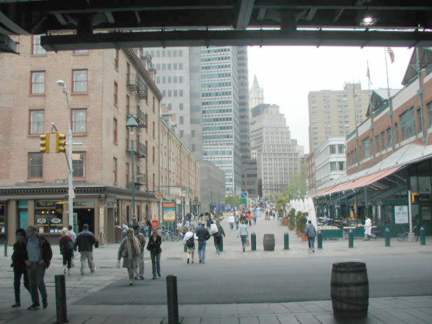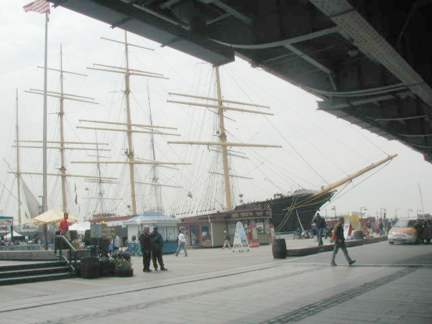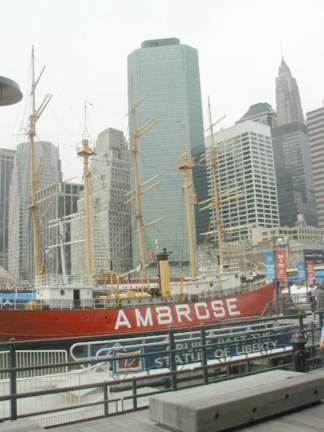Fulton Street, which runs in Lower Manhattan from Church Street east to theSouth Street Seaport, is a crazy quilt of mom and pop businesses, souvenir tourist traps, historic cast iron and late 19th Century buildings and some of the weirdest architectural juxtapositioning you’ve ever seen. Let’s scratch the surface and work our way east to west.

Fulton is the main street of the South Street Seaport Historic District, which in your webmaster’s opinion is just a little too affected and lays it on a bit thick, but it must be remembered that back in 1983 it was built mainly for the tourist trade. Even its original incarnation, the Fulton Fish Market, will soon be decamping to the Bronx and the area’s bracing fishy odor will soon be just a memory. There’s no way we can recreate odors in Forgotten NY, but I’m sure the geniuses at Redmond and Cupertino are working on it. There’s plenty of historic gems in the area that are overlooked by both dyed in the wool NYers and tourists, and we intend to do an entire Forgotten page on them eventually.
[2012: The Fish Market is now in Hunts Point in the Bronx]
In the above photo, looking down Fulton from South, the brick building, #2-4 Fulton, on the left is especially noteworthy; for decades it housed Sloppy Louie’s fish joint and Sweet’s Restaurant, and it is the building celebrated by The New Yorker writer Joseph Mitchell in his collected works, entitled Up in The Old Hotel. Sweet’s was destroyed by a nor’easter in December 1992 and Sloppy Louie’s hung in there until 1998. Many buildings along South Street were hotels and flops, and Mitchell gives an indelible description of #4 Fulton when it was one such hotel in the mid-20th Century.
The building along the right side of the picture looks older than it is; it was built in the early 1980s as a representation of the Bogardus Building, which was stolen. Yes, stolen: a warehouse built by cast-iron architecture pioneer James Bogardus at Washington and Murray Streets in Washington Market on the Lower West Side was taken down during construction of the World trade Center and was actually stolen for scrap iron.
At the east end of Fulton Street can be found two historic sailing ships, the Peking and the Wavertree, plus one of NYC’s few remaining floating lighthouses, or rather, lightships, the Ambrose, which served the Port of New York, the Coast Guard and Fort Hancock, NJ (as an examination ship) from 1908 to 1966. Since 1968, the Ambrose has been docked at the Seaport and has been a floating museum since then.

South Street was once lined with sailing ships like the Peking.

The Ambrose is named for Ambrose Channel, the southern entrance to NY harbor, where it was stationed in its early years. The first Ambrose Light Tower replaced the lightship in 1967 (it was replaced in 1999); today the Ambrose is one of the few lightships remaining intact. The Titanic Memorial Lighthouse, formerly atop the Seaman’s Church Institute on State Street, stands at Fulton and Pearl Street.
hip chandler (person who supplied onboard equipment) Peter Schermerhorn Jr. built this Georgian row of buildings on #2-18 Fulton between 1810 and 1812. He first had to fill in the land; Front Street, as its name implies, was the approximate original shoreline. The original Fulton Ferry, which ran between Manhattan and Brooklyn’s Fulton Streets, began to bring foot traffic beginning in 1814 and in that year, the first storefronts appeared on Schermerhorn Row. The mansard roof and dormer windows near South Street were added in the 1860s; many additions and amendations have been done over the years. Schermerhorn Row was restored in 1983 as part of the Historic District construction.
1820s and 1980s architecture come together on Front Street facing Fulton.
The South Street Historic District‘s distinctive lampposts are close replicas of those that existed here in the late 1800s and early 1900s.
Narrow Pearl Street, one of the longest streets in lower Manhattan (except for Broadway) crosses Fulton Street where there was once an el station: the 2nd-3rd Avenue El ran up Pearl Street on its way to Chatham Square and then the Bowery and 3rd Avenue. Looming at the rear is the third tallest building in NYC, 66-story American International Bldg. at 70 Pine Street, once known as the Cities Service Tower and featuring an Art Deco lobby (a riot of marble) and a greenhouse aerie at the top floor that is, of course, closed to the public. The loss of the great skyscraper observation decks is one of the unfortunate occurrences of our age.
Moving west, at Gold Street, Fulton takes a turn to the northwest. The streets here are some of Manhattan’s narrowest.
East of Broadway, Fulton St. was once known as Fair Street; west of Broadway, Partition Street. Both Manhattan and Brooklyn’s Fulton Streets are named for steamship and submarine pioneer Robert Fulton.
The triangle formed by Gold and Fulton Streets is called John Delury Senior Plaza, after the longtime labor leader of the Uniformed Sanitationmen’s Association.
Nearby Worth Street is also called “Avenue of the Strongest”, after the NYC sanitationmen’s sobriquet.
The Fulton Street subway station under William Street links BMT, IND and IRT lines and is slated to be the focus of a massive ‘transit hub’ to be constructed over the next decade, with a huge station building on Broadway. There is even discussion about running Long Island trains to the proposed hub.
Robert Fulton’s steamboat, the Clermont, which made its maiden voyage in 1807, is featured on the IRT platform in 4 landmarked ornate plaques made in 1905 by Rockwood Pottery. When the plaques were placed here the voyage was nearing its centennial; now it’s approaching its 200th anniversary!
According to some sources, Fulton’s fame is misplaced. Twenty years earlier, James Rumsey and John Fitch had each run steamboats on the Potomac and Delaware Rivers respectively. And, Fulton’s biographer, Cadwallader Colden, had Fulton name his steamboat the Clermont even though Fulton himself apparently never called it anything but North River Steam Boat!
In the corridor that connects the IRT platform (4, 5) at Fulton Street to the BMT (J, M, Z) and IND (A, C) are six large terra cotta designs that were not originally in the station, but seem to be very much of a piece with it. They were produced in the same era (1915) and originally could be found in the Maritime Grill in the McAlpin Hotel in Herald Square. Large ocean liners like the Mauretania and Commonwealth are depicted as well as the steamboat Clermont, in brilliant color.
Cliff Street used to run from John Street north past Fulton to a little alley called Hague Street just south of Chatham Square; these days, it’s just a one block stretch ending at Fulton. Even on this one short block are three buildings dating to mid-1830s. Of the three, only the one with Maguire’s Ale House on the ground floor has been relatively unaltered.
Gold Street, seen here near its intersection with Fulton, gives you a good idea of the narrowness of the streets in the area; they were originally built for horse and oxcarts and foot traffic, not cars. The street is named for long-since leveled Golden Hill, which was in turn named for the color of a wheat grown in the area. Gold Street near Fulton has some interesting artifacts of its own…
The spectacular Excelsior Power Company Building cast iron sign has been hidden here on 33 Gold Street since 1888. The Queen Anne style building was designed by William Grinnell. Speaking of cast iron…
A “Type G” wall bracket lamp here has somehow evaded the notice of the Department of Transportation. Hey, if you don’t tell anyone, we won’t.
Edens Alley is one of NYC’s oldest alleys and also one of its newest. It shows up on early maps, but its name was changed in 1842 to Ryders Alley. In the 1990s, a compromise of sorts was reached and the very short part of Ryders that ran to Gold street was renamed Edens, while the other part of the dogleg kept Ryders.
It was named for a landowner named Medcef Edens.
Above and below: The Royal Insurance Company Building on the northeast corner of William and Fulton dates to 1927. Note the interlocking R, I, C on the frieze above the door.
Similar interlocking letters are just across the street on William on the Fidelity and Deposit Building along with a close-up view of Your Webmaster’s thumb. Sort of looks like the White House, which was also built in the Federal style.
Nassau Street, a pedestrian walkway during the week, has several classics dating back to several eras. At left, the Fulton Building (1891) is classified as a Renaissance Revival building with brick, limestone and terra cotta; just across the street, at right, is the Bennett Building, named for James Gordon Bennett, owner of the New York Herald, built by Arthur Gilman in 1872 with the upper 4 floors added in 1892. Cast iron facades this far south are unusual: most are in Soho to the north, but as we’ll see, Nassau Street has several specimens.
The advertisers would prefer you to look at the billboard, but instead, here’s another initial at 83 Nassau Street. What does the ‘L’ stand for? Perhaps the architect’s mother was named Laura or Linda.
At 63 Nassau, you will find a very interesting scaffolding example…just kidding. Actually by some accounts, this building was built in the 1860s by the cast iron granddaddy, James Bogardus.
Architecture in the late 1800s, and especially cast iron architecture, is renowned for its detail. Note the two Ben Franklin bas-relief portrait busts.
Note the unironic patriotic depiction. In the mid-1800s, and for that matter, on into the 1960s, for better or for worse, the use of patriotic images showing heroes of the past was an accepted, perhaps even expected, part of architecture. The Swingin’ Sixties changed everything as authority was questioned more and more.
Fulton Street is also a depository for some very old business signage. Even in a wired society like this, offices still use basic things like staples, rubber stamps and paper products. It’s likely American Stamp Manufacturing’s illuminated sign has been doing the job for decades; there’s no need to change it. Close by is an ancient ad for a framing concern with a pointing finger; there’s no discernable framing business here anymore and the ad is at least several decades old.
Ever-present scaffolding obscures intricate detailing at 127 Fulton Street, the Keuffel & Esser Building, built in 1893. Architects DeLemos and Cordes used this as a dry run for their later confections, the Siegel-Cooper and Macy’s department store buildings. Peering around the scaffolding will let you see the cast-iron detailing, renderings of drafting implements and for some reason, a winged wheel.
Let’s leave Fulton for a moment and go a block south to Broadway and John Street where we find the 1889 Corbin Building, designed by Francis Kimball, renowned for his decorative use of terra cotta. The Renaissance Revival building is chock full of detail and carved brownstone. Dig the two “green men” and snake attacking a bird above the doorway on 11 John Street, as well as two griffin-like figures above the scaffold.
Back on Fulton, just west of Broadway, is an original chiseled “Subway” sign installed in the 1930s when the IND opened its Broadway-Nassau station (the IND complement to the Fulton Street subway complex). At right are several historical artifacts all rolled into one: an angular 1970s modern front was grafted onto what looks like an 1890s Beaux-Arts building! At one time, no doubt, the two lamps at the top lit up. The building is now occupied by a jewelry shop and tanning salon but its former business, a copy shop, still has a sign. The “facsimile” and “typewriter” ads look quaint as we roll into the mid-2000s!
Soon, this stretch of Fulton Street and Broadway may look vastly different. There are already plans to spiff up this section of Broadway with new sidewalks and lampposts, and in a few years, a grand new “transit hub” may rise on the other side of Broadway which may mean the demolition of several historic buildings.
Fulton Street is shorter than it used to be. The stretch between Church and West Streets was closed so that the World Trade Center could be constructed on what was formerly Radio Row and the Washington Market.
Miraculously, St. Paul’s Chapel, on Broadway between Fulton and Vesey, survived the 2001 terrorist attack with barely a scratch. The chapel was built by Thomas McBean beginning in 1764, with the steeple added in 1794 (since replaced), and the altar is by Pierre L’Enfant–who later went on to draw up the plan for the nation’s capital in Washington, DC. L’Enfant also designed buildings in Brooklyn and Flushing, Queens! Few of them are still standing, however.
Both St. Paul’s Chapel and churchyard are landmarked. Here interred are Richard Montgomery, the Revolutionary general killed in the Battle of Quebec; John Wells, who co-edited The Federalist Papers with Alexander Hamilton; and Christopher Colles, who built the first NYC water works.
Park Row, seen here looking south to Broadway, runs northeast from Broadway just north of Fulton Street and connects it with the Bowery and the East Side. Park Row is one of Manhattan’s oldest roads and first shows up in official documents and maps as early as 1671! Along with the Bowery it functioned as the first Boston Post Road and wound irregularly on the East Side till it crossed the Harlem river by ferry and connected to a network of roads leading to Boston. The Bronx’ Boston Road is also a former Post Road route.
Tough to make it out here, but NYC’s Department of Transportation installed new blue street signs in the World Trade Center site area featuring an American flag with “9-11-01” beneath it. By 2012, these had disappeared.
SOURCES:
Cast-Iron Architecture in New York, Margot Gayle and Edmund Gillon, Dover 1974
BUY this book at Amazon.COM
South Street: A Photographic Guide to New York City’s Historic Seaport, Ellen Fletcher Rosebrock, South Street Seaport 1999
BUY this book at Amazon.COM
On Broadway: A Journey Uptown over Time, David Dunlap, Rizzoli 1990
BUY this book at Amazon.COM
Up in the Old Hotel, Joseph Mitchell, Vintage 1993
BUY this book at Amazon.COM
Cast-Iron Architecture in America: The Significance of James Bogardus, Margot Gayle, Carol Gayle and Philip Johnson, W.W. Norton 1998
BUY this book at Amazon.COM
Lighthouses of New York, Jim Crowley, self-published 2000; www.nylighthousephotos.com
Inspired by
“A Distant Past Is Just A Local Stop” by Glenn Collins, New York Times, April 28, 2003
Thanks to Forgotten Fan Joseph Schlesinger for help with this page.
5/11/2003; revised 2012